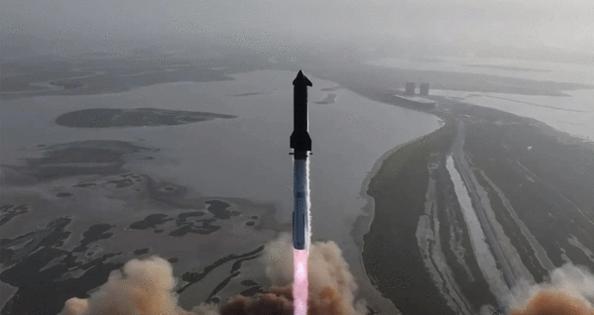SpaceX Starship avoids explosive fate of last 2 launches, but still suffers demise midflight
Published in News & Features
ORLANDO, Fla. — SpaceX managed to send its developmental Starship back into space surpassing the explosive fates that befell its last two attempts, while also for the first time flying with a reused Super Heavy booster. But not everything went well with the upper stage, which lost control during its suborbital trip halfway around the Earth.
The massive combined rocket and spacecraft began its the ninth suborbital test flight well, lifting off from the company’s Texas site Starbase at 7:37 p.m. Eastern time.
“It’s one hell of sight from here,” said SpaceX commentator Dan Huot. “We see it arcing right over top of us, we see 33 out of 33 Raptor engines lit on Super Heavy as it starts to ascend skyward.”
“That was incredible. We could feel the building shaking here, feel the vehicle’s power,” added SpaceX’s Jessie Anderson.
The booster’s reuse was mostly successful having previously flown in January. Unlike its last trip, SpaceX was not attempting a recovery back at the launch site, and the booster broke apart shortly before its attempted splashdown over the Gulf waters off the coast of Texas.
But it did successfully send the Starship upper stage on its way into suborbital space, improving on the January and March attempts this year that both ended with the upper stage disintegrating soon after launch leaving trails of debris visible from South Florida and the Caribbean.
While the investigation into the March flight’s demise is ongoing, the Federal Aviation Administration last week gave SpaceX the OK to go with was the third Starship launch of the year and ninth suborbital test flight overall.
But there was no storybook ending for this mission, as SpaceX lost contact with Starship somewhere over the Indian Ocean so it never made it to the planned splashdown site off the western coast of Australia.
SpaceX hit its first snag with the upper stage when it failed a payload door test that was supposed to let the company deploy some Starlink satellite simulators using what commentators called its PEZ dispenser.
The door didn’t open all the way, so SpaceX opted to close it and continue on with its prime objective, which was to survive reentry, part of its eventual effort to have the Starship upper stage to return safely to the launch site.
About 30 minutes into the flight, though, Huot revealed Starship had suffered some sort of leak in its fuel tank systems causing it to be in “in a little bit of a spin” and that prompted the company to skip another planned test of relighting of one of its Raptor engines midflight.
“At this point, we’ve essentially lost our attitude control with Starship. We are still on a path toward reentry. We are suborbital, so no matter what we are going to enter, however, this lowers the chances for it to be a controlled reentry,” he said. “So not looking great with a lot of our on-orbit objectives for today. We were hoping to do the PEZ deploy and relight an engine, and then, really importantly, get into that controlled entry to really put the heat shield through the ringer.”
Without any control, SpaceX opted to dump all of the spacecraft’s remaining fuel. In the end, the company lost contact with Starship about 45 minutes into flight.
“We’re continuing to learn more about this ship, about this rocket,” Huot said. “We are trying to do something that is impossibly hard, and it’s not always going to — you’re not going to reach it in a straight line. We said there’s going to be bumps, there’s going to be turns, but seeing that ship in space today was a hell of a moment for us.”
To date all launches have been from Texas, but the company is building out two launch sites on the Space Coast.
At more than 400 feet tall and the booster producing more than 16 million pounds of thrust at liftoff, Starship is the biggest and most powerful rocket that has made it to space, although it has yet to perform an orbital launch.
NASA has a vested interest in the system getting completed as a version of Starship has been tapped to be the human landing system for the Artemis III mission that seeks to return humans to the moon for the first time since the end of the Apollo program in 1972.
Despite the partial failure of flight 9, the FAA this year increased SpaceX’s license so it can fly up to 25 missions a year out of Texas.
“This is exactly the SpaceX way,” Anderson said. “We’re going to learn, iterate and iterate over and over again until we figure it out.”
-----------
©2025 Orlando Sentinel. Visit at orlandosentinel.com. Distributed by Tribune Content Agency, LLC.







Comments